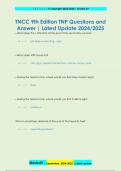1 | P a g e | © copyright 2024/2025 | Grade A+
TNCC 9th Edition TNP Questions and
Answer | Latest Update 2024/2025
—What does the J stand for at the end of the secondary survery?
✓ ~~> just keep evaluating - vipp
—What does VIPP stand for?
✓ ~~> vital signs, injuries/interventions, primary survey, pain
—During the head-to-toe, where would you find Grey-Turner's sign?
✓ ~~> flank
—During the head-to-toe, where would you find Cullen's sign?
✓ ~~> umbilicus
-What is sometimes deferred at the end of the head-to-toe?
✓ ~~> inspecting posterior
Master01 | September, 2024/2025 | Latest update
, 2 | P a g e | © copyright 2024/2025 | Grade A+
-Antibiotics, consults, head CT, imaging, law enforcement, mandatory
reporting, psychosocial support, social services, splinting, tetanus, and wound
care are all interventions that you do AFTER and before WHAT?
✓ ~~> AFTER head-to-toe, BEFORE J (VIPP)
-What three items are obtained during the pertinent history assessment?
✓ ~~> Medical records, prehospital report, SAMPLE
-What are examples of nonpharmacologic measures? (must identify at least
one during testing)
✓ ~~> Distraction, family presence, padding bony prominences,
repositioning, splinting, verbal reassurance
-For whom is capnography highly recommended?
✓ ~~> all patients
-In step M of "Get Adjuncts", what else might be indicated besides cardiac
monitor?
✓ ~~> EKG
Master01 | September, 2024/2025 | Latest update
, 3 | P a g e | © copyright 2024/2025 | Grade A+
-In Step 16 of "Exposure and Environment", you must name at least one of
these interventions:
✓ ~~> blankets, room temp increase, warmed fluids, warming lights
-To assess circulation, you must do these two main tasks:
✓ ~~> 1. inspect AND palpate skin color, temp, moisture and 2.
palpate a pulse
-What do you do when alterations are identified in any of the steps in the
primary survery?
✓ ~~> intervene as appropriate and reassess
-What three assessments must be done if the patient is intubated?
✓ ~~> 1. attach CO2 detector and assess for evidence of exhaled
CO2; 2. observe for rise and fall of the chest w/ assisted ventilations; 3.
auscultate over epigastrium for gurgling AND lungs for bilateral breath
sounds
-Four of these must be identified to assess breathing effectiveness:
Master01 | September, 2024/2025 | Latest update
, 4 | P a g e | © copyright 2024/2025 | Grade A+
✓ ~~> Breath sounds, depth/pattern/rate, spontaneous breathing,
subcutaneous emphysema, increased work of breathing, symmetrical
chest rise and fall, tracheal deviation/JVD, open wounds/deformities,
skin color
-What can be applied in step 12 of "Circulation and Control of Hemorrhage"
for which credit is given in the LMNOP section?
✓ ~~> cardiac monitor
-When should 2 IV sites be established?
✓ ~~> During "Circulation" assessment
-If the patient is intubated and you've already assessed ETT placement, what
else needs to be done with the ETT? (step 10)
✓ ~~> assess ETT position by noting the number at teeth/gums AND
secure ETT
-What should you verbalize after completing all ETT assessments?
✓ ~~> moving patient from assisted ventilation to mechanical
Master01 | September, 2024/2025 | Latest update




